8 September 2012
The Puja Guesthouse rooftop is my much needed retreat from all that is Varanasi. Today I’ve seen and smelt burning corpses, played sitar in a small house that was once visited by Paco de Lucia, participated in Ganga Aarti, and stepped in a pile of steaming cow shit. I’m hot, sweaty, tired, and thankful for this rooftop breeze.
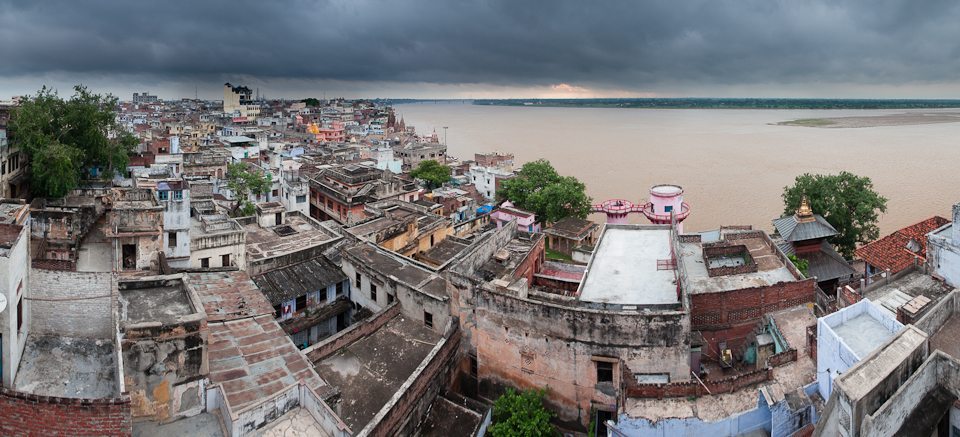
Rooftops of Varanasi Old City – viewed from Puja Guesthouse
The uncomfortable beds make for easy early wake-ups. I average 5 hours of sleep per night because of my sunrise boat trips on the Ganges at 5 AM. Waking up early in India is worth it – it could be the only peace and quiet you experience all day. Every day here is packed to the brim, and nothing is planned. Things just happen.
I arrived here on September 5 and grabbed a tuk-tuk from airport to the Ganges, stopping at a camera store along the way to find (to my great, enormous, immeasurable joy) a battery charger for my camera. Who leaves their camera battery charger at home when they go on a photography trip? I do.
I pay my driver 100 Rs + 1 banana and walk into PG Guesthouse, near Assi ghat. The room at PG is the definition of squalor and at a rate of 300 Rs/night, I’m not buyin’. I walk down the slummy alleyway to the river and find that everyone wasn’t kidding when they said it was flooded. That is one big muddy river. Walking along the ghats would be impossible, to my great dismay. I had been looking forward to the ghats – the large stairways – leading down to the Ganges from the city of Varanasi.
Rather than walk the river, I walk through the old city. The alleyways gradually became livelier. The back streets of the Varanasi old city are difficult to describe. They are at once beautiful and filthy, unique and repetitive, spiritual and full of sin. Cows, and at times inconveniently aggressive bulls, roam these narrow streets. They shit and piss everywhere as do many of the local people. The cattle belong to no one- they are like stray dogs, yet they are holy because they eat trash, take nothing, and give milk to those in need. I suppose that is one way of looking at it.
Troops of monkeys acrobatically negotiate rooftops while stray dogs rummage through rubbish in the streets. I step over a sewage gutter – everything is open air – and pass a large street food operation. the men are making puri and pakora. Pakora is stuffed with vegetables, and puri is just flatbread. They are both deep friend. The man who appears to be in charge beckons me closer as I happily snap away.
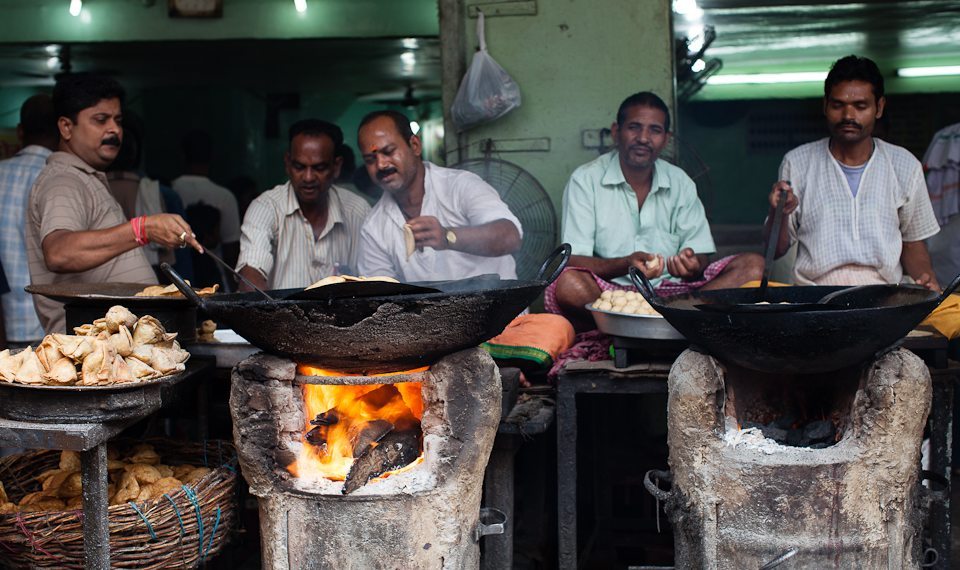
Varanasi Breadmen
One can only handle the old city streets for so long. Everyone persistently, sometimes vehemently, asks me to come to their shop. Silk is everywhere, and everyone has an honest uncle with a silk shop. At first, I had illusions that maybe someone who approaches me is seeking my friendship. I don’t think that will ever happen. I know better now, and I only needed a couple days to figure it out. Locals interacting with tourists are always in it for themselves-something must be gained. It is really too bad. I look at each Indian with a guarded, wary eye. I’m so curious about their culture and have so many questions, but no one will give me honest time.
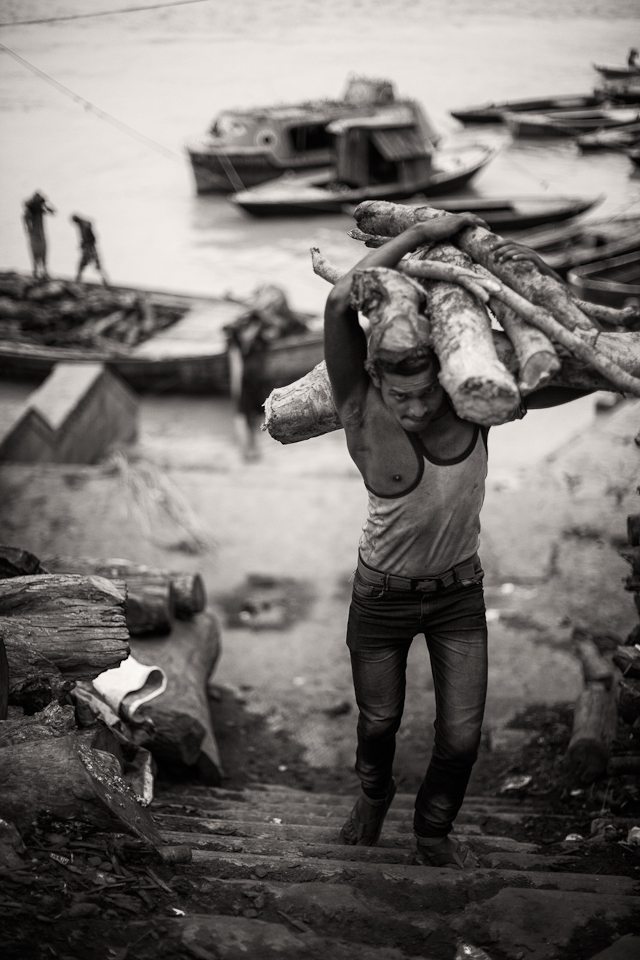 Varanasi embodies the concept of foreign. Nothing is familiar. At Manikarnika ghat funeral pyres burn all day and all night. The wind billows the ashes of the dead through the air, swirling out over the river. Proximity to Manikarnika is evident from the smell of burning, the heaps of wood, and the glow of the pyres. While ducking into a side-alley I see a funeral procession pass. Bodies of the dead are carried, wrapped in colorful fabric, through the maze of streets to the ghat by a procession of chanting Indians. Before cremation the men remove the colorful fabric to reveal a pure white cloth wrapping and dip the body into the Ganges to purify the deceased. The bodies are burned individually on large wooden pyres. The wood used for the cremation fires is stacked everywhere, and provides an entire industry in Varanasi. Sandalwood is the most expensive, and the men of the ghat weigh each log as they determine how much wood is required to burn a body. Children, pregnant women, and sadhus are not cremated – their bodies are placed directly in the river, because they are already pure. The burning is a purification process of the Hindu soul.
Varanasi embodies the concept of foreign. Nothing is familiar. At Manikarnika ghat funeral pyres burn all day and all night. The wind billows the ashes of the dead through the air, swirling out over the river. Proximity to Manikarnika is evident from the smell of burning, the heaps of wood, and the glow of the pyres. While ducking into a side-alley I see a funeral procession pass. Bodies of the dead are carried, wrapped in colorful fabric, through the maze of streets to the ghat by a procession of chanting Indians. Before cremation the men remove the colorful fabric to reveal a pure white cloth wrapping and dip the body into the Ganges to purify the deceased. The bodies are burned individually on large wooden pyres. The wood used for the cremation fires is stacked everywhere, and provides an entire industry in Varanasi. Sandalwood is the most expensive, and the men of the ghat weigh each log as they determine how much wood is required to burn a body. Children, pregnant women, and sadhus are not cremated – their bodies are placed directly in the river, because they are already pure. The burning is a purification process of the Hindu soul.
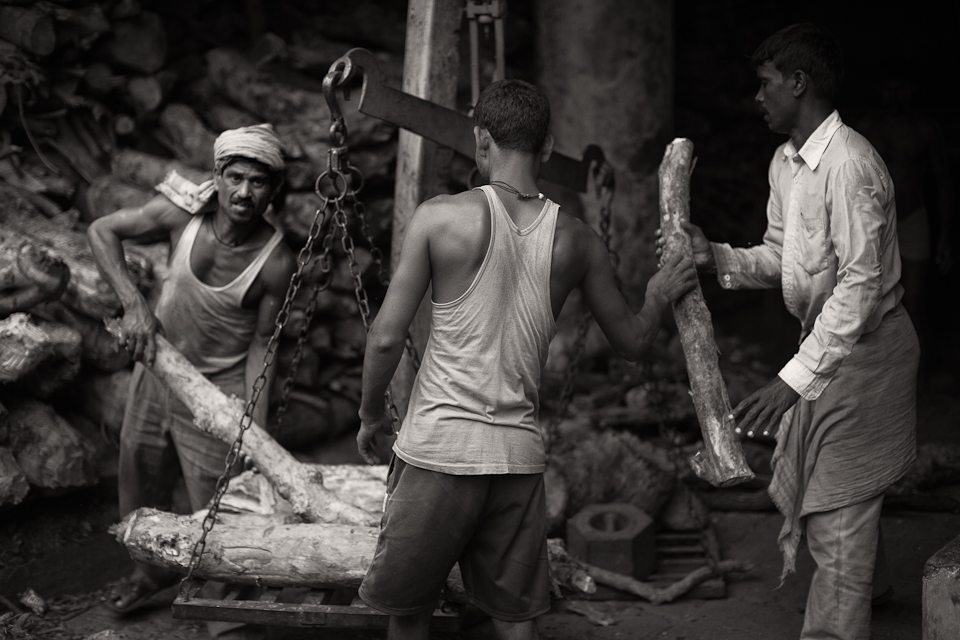
There is another tradition in the area dominated by fire – the Ganga Aarti. In the Hindu faith, puja is offering – giving to a deity in exchange for a blessing. Aarti is a fire worship ritual and is part of puja. There is a ceremony every night at Dasaswamedh ghat in Varanasi where many gather to watch the ceremony as priests circulate large fiery plates and make ritual chants. Attendees make their own personal offerings in the form of small aarti plates made from leaves, flowers, and candles. Devotees light the aarti and push it out into the Ganges. I made three aarti offerings to the Ganga – one each for my mother, father, and sister.
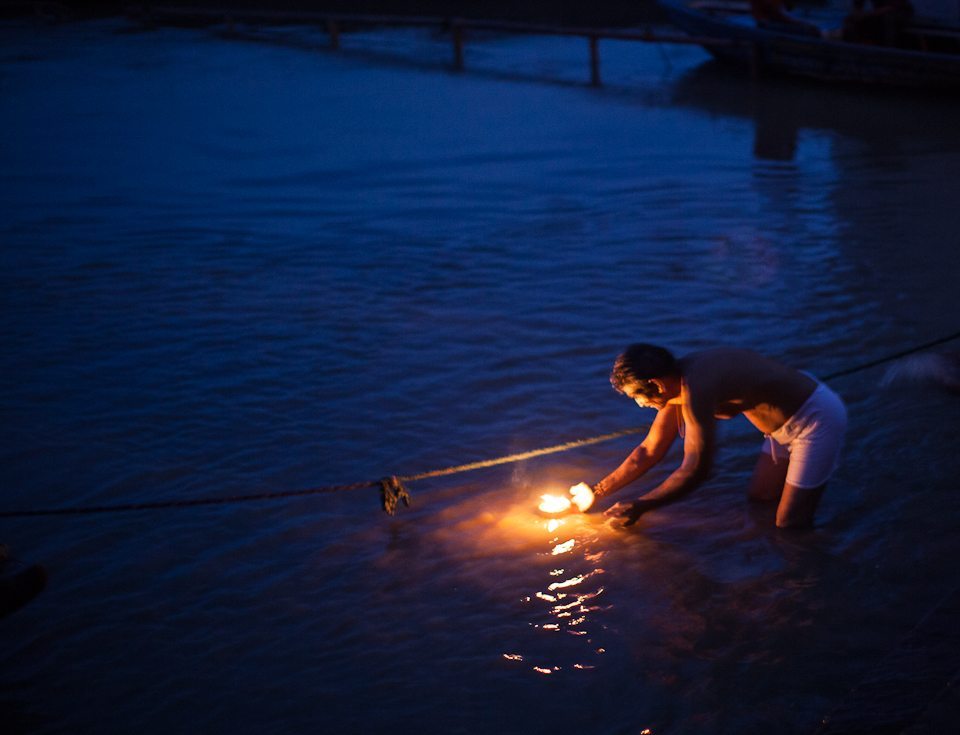
An Indian man offers aarti to Goddess Ganga
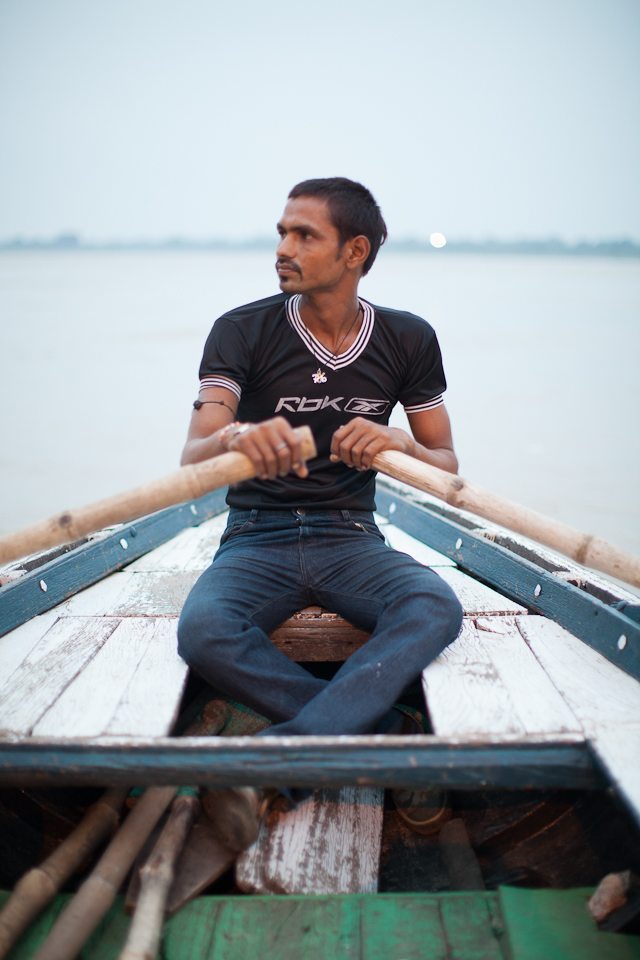 My retreat from this burdensome atmosphere is the boat rides on the Ganges. Twice Raj has been my boatman. We push out into the flooded river before the sun rises and I prepare my camera gear as Raj settles into a rowing rhythm, sometimes chanting, sometimes silent, sometimes grunting. In those quiet mornings on the Ganga, Raj tells me about his past, his time in the army, his lost love. Out on the water he tells me about how he lost faith in one religion and found faith in another. He declares his aspirations, his hopes for good karma, and proudly shows off his muscles honed from hours of rowing. Raj is an excellent boatman and understands my desires during the morning boat rides. He navigates to the liveliest ghats where the churning colorful masses bathe in the holy waters.
My retreat from this burdensome atmosphere is the boat rides on the Ganges. Twice Raj has been my boatman. We push out into the flooded river before the sun rises and I prepare my camera gear as Raj settles into a rowing rhythm, sometimes chanting, sometimes silent, sometimes grunting. In those quiet mornings on the Ganga, Raj tells me about his past, his time in the army, his lost love. Out on the water he tells me about how he lost faith in one religion and found faith in another. He declares his aspirations, his hopes for good karma, and proudly shows off his muscles honed from hours of rowing. Raj is an excellent boatman and understands my desires during the morning boat rides. He navigates to the liveliest ghats where the churning colorful masses bathe in the holy waters.
Varanasi is one of the craziest, most colorful, full-of-culture, downright dirty, filthy, holy, foreign places I’ve ever been. I suggest a visit to everyone, but know what you are getting into! Nothing can prepare you for the wild streets of Varanasi!
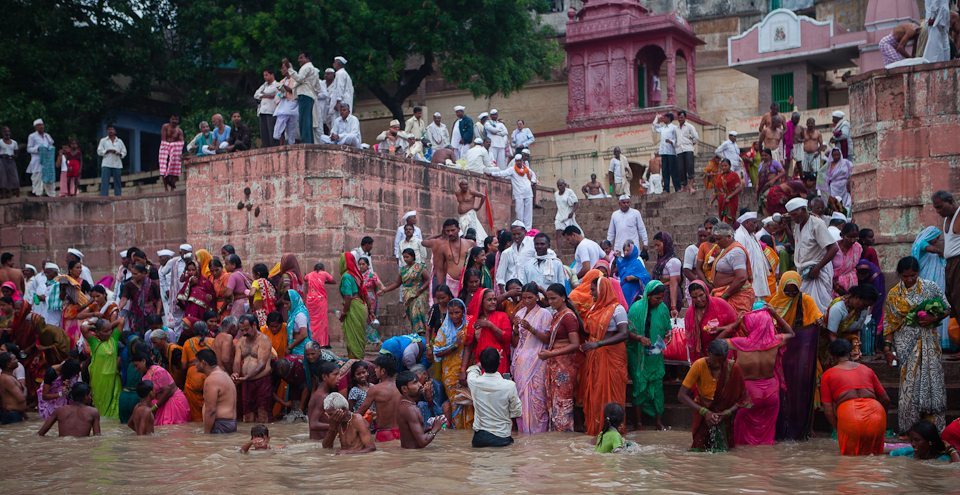
Bathing in the waters of Mother Ganga
Travel Tips
Best Eats: Blue Lassi behind Manikarnika Ghat (literally the best lassi of all my travels in India)
Best Rooftop View: Puja Guesthouse near Lalita Ghat (double w/ bath 300 Rs/night)
Morning Rowboats: find a boatman at Mir Ghat at 5 AM – 100 Rs/hr/person for groups, 200 Rs/hr to go alone (recommended)
Special Goods: Silks and sitars

Leave a reply